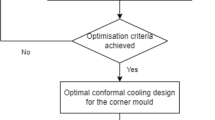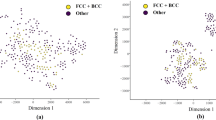Abstract
A review of the current understanding of heat transfer from quenched alloy products to water sprays is presented. A numerical example is described to demonstrate how controlled spray cooling of products containing sections of differing thicknesses significantly reduces thermal gradients. A semi-expert computer-aided design (CAD) system is proposed for optimizing the process of spray quenching following extrusion, forging, or continuous casting. A systematic experimental approach to the problem of providing a universal heat transfer data base for the proposed CAD system is presented.
Similar content being viewed by others
Abbreviations
- cp :
-
specific heat of alloy at constant pressure (J/kg K)
- d:
-
drop diameter (mm)
- h:
-
convection coefficient (W/m2K)
- k:
-
thermal conductivity of alloy (W/m K)
- P:
-
pressure (kPa)
- q:
-
local heat flux (W/m2)
- Q:
-
local volumetric spray flux (m3 s−1/m2)
- t:
-
time (s)
- T:
-
temperature (°C)
- ΔTS :
-
T s−T sat (°C)
- u:
-
drop velocity at impingement (m/s)
- p:
-
density of alloy (kg/m3)
- f:
-
inlet water conditions
- i:
-
initial
- s:
-
metal surface
- sat:
-
saturation
References
A.L. Lefebvre, 1988,Atomization and Sprays, Hemisphere Pub. Corp., New York.
J. Chevier, A. Simon, and G. Beck, 1981, “Optimal Cooling Rate and Process Control in Metallic Parts Heat Treatment,” InHeat and Mass Transfer in Metallurgical Systems, B. Spalding, ed., Hemisphere Pub. Corp., New York.
J.K. Brimacombe, P.K. Agarawal, L.A. Baptista, S. Hibbins, and B. Prabhakar, 1980, “Spray Cooling in the Continuous Casting of Steel,”63rd National Open Hearth and Basic Oxygen Steel Conf. Proc., Vol. 63, Washington, DC, pp. 235–252.
L. Bolle, and J.C. Moureau, 1976, “Spray Cooling of Hot Surfaces: A Description of the Dispersed Phase and a Parametric Study of Heat Transfer Results,”Proc. of Two Phase Flows and Heat Transfer, Vol. III, NATO Advanced Study Institute, pp. 1327–1346.
L. Bolle and J.C. Moureau, 1979, “Experimental Study of Heat Transfer by Spray Cooling,”Proc. of Int. Conf. on Heat and Mass Transfer Metallurgical Processes, Dubrovnik, Yugoslavia, pp. 527–534.
K. Sasaki, Y. Sugitani, and M. Kawasaki, 1979, “Heat Transfer in Spray Cooling on Hot Surface,”Testu-To-Hagane, Vol. 65, pp. 90–96.
H. Muller and R. Jeschar, 1973, “Untersuchung des Warmeubergangs an einer simulierten Sekundarkulhzone beim Stronggiessverfahrer,”Arch. Eisenhuttenwes, Vol. 44, pp. 589–594.
L.I. Urbanovich, V. Goryainov, V. Sevost’ynov, Y. Boev, V. Niskovskikh, A. Grachev, A. Sevost’yanov, and V. Gur’ev, 1981, “Spray Cooling of High-Temperature Metal Surfaces with High Water Pressures,”Steel in the USSR, Vol. 11, pp. 184–186.
U. Reiners, R. Jeschar, R. Scholz, D. Zebrowski, and W. Reichelt, 1985, “A Measuring Method for Quick Determination of Local Heat Transfer Coefficients in Spray Cooling Within the Range of Stable Film Boiling,”Steel Research, Vol. 56, pp. 239–246.
E.F. Bratuta and S.F. Kravtsov, 1986, “The Effect of Subcooling of Dispersed Liquid on Critical Heat Flux with Cooling of a Plane Surface,”Thermal Engineering, Vol. 33, pp. 674–676.
Author information
Authors and Affiliations
Rights and permissions
About this article
Cite this article
Deiters, T.A., Mudawar, I. Optimization of spray quenching for aluminum extrusion, forging, or continuous casting. J. Heat Treating 7, 9–18 (1989). https://doi.org/10.1007/BF02833183
Issue Date:
DOI: https://doi.org/10.1007/BF02833183




